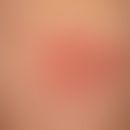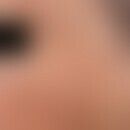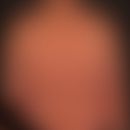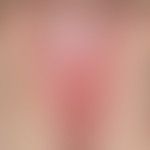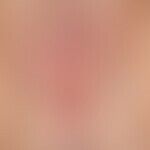Synonym(s)
DefinitionThis section has been translated automatically.
Acquired, chronic inflammatory (autoimmunological) non-infectious, lichenoid disease, leading to sclerotherapy, scarring distortion and consecutive dysfunction of the vulvar skin and mucous membrane. Triggering by allergies (e.g. type I allergies) is possible. Furthermore, hormonal influences may play a role, recognizable by the prepubertal and postmenopausal manifestation peaks.
ClassificationThis section has been translated automatically.
Grade 1: One or more small (1-3 cm), circumscribed, non-sclerosed, largely asymptomatic whitish plaques. No significant atrophy of the surface epithelium, GV possible without symptoms.
Grade 2: large, sharply or blurred, moderately itchy (especially after mechanical irritation), slightly indurated, whitish plaques following a W- or 8-figure around the vaginal introitus and anus. Incipient or pronounced, parchment-like atrophy of the skin (disappearance of the surface relief) and the vulvar mucosa (inner labia, clitoris). Intercourse may be slightly painful (dyspareunia).
Grade 3: extensive, itchy and also slightly painful, sharply or blurredly defined whitish plaques with a shiny whitish surface; marked tendency for the affected areas to shrink; lesional ecchymoses of different ages (light red to black coloration), incipient adhesion/fusion of small and large labia, dyspareunia.
Grade 4: Late stage of LS; shrinkage of the entire white porcelain-like, lesional areas with blunt, easily injured surfaces. Red to blue-black ecchymoses of different ages, extensive fusion of the large and small labia; subtotal introitus stenosis, buried clitoris. Dyspareunia or complete apareunia. Stenosis of the external orificium of the urethra, possibly with deflected urinary steel, painful lesional fissures or extensive erosions; formation of extensive ulcers possible. Possible stenosis of the anus with painful anal fissures.
You might also be interested in
Occurrence/EpidemiologyThis section has been translated automatically.
Only estimated figures are available on the epidemiology of lichen sclerosus of the vulva, as apparently only a smaller tel is diagnosed. It is assumed that the average prevalence is about 1% (Kirtschig G 2016). Prevalences of 0.1% are reported in prepubertal girls and 3% in >80-year-olds.
The comparison of prevalences between German and international literature suggests that the disease is currently diagnosed far too rarely in Germany (Schürch HG 2018).
ManifestationThis section has been translated automatically.
Basically at any age. Significant increase in prevalence at an older age.
ClinicThis section has been translated automatically.
Prepubertal: Typical is an infestation of the large labia with initially little indurated, borderlessly blurred, glossy-white, almost mirror-like, surface-smooth plaques. The changes can spread to the perineum and further to the anal zone. The circular infestation of vulva and anus results in a typical 8-formation. The initial Lichen sclerosus foci usually do not cause any symptoms. Occasionally slight itching is indicated. Often the diagnosis LS results from a random finding. Vitiligo can be excluded by differential diagnosis. In children with anal infestation constipation may be a further consequence. Note: the infantile lichen sclerosus can lead to a sclerosing atrophy of the small labia with the image of a "gaping vagina". Here the suspicion of infantile abuse may arise.
Postpubertal: In adults, depending on the degree of LS (see classification), torturous pruritus, sometimes combined with pain, especially during sexual intercourse or under mechanical stress, are in the foreground. Occasionally genital or anal bleeding also occurs. Sometimes LS is also a chance finding in otherwise healthy women.
Clinically, postpubertal LS is characterized by whitish, atrophic, porcelain-like, clearly increased plaques, which are usually well distinguishable from healthy skin and mucous membranes, with a tendency to shrinkage and scarring of the small and large labia. Bleeding, painful rhagades (especially in the area of the posterior commissure) with a tendency to superinfection are complicative superimpositions of the vulval LS. In addition, extensive, unusually long persistent lesional bleeding is also found (this can be the reason for a medical consultation). Fresh (red coloration) or older (black or blue-black coloration) lesional bleeding may dominate the clinical picture and be diagnostically irritating (sclerosis is covered by the extensive bleeding).
In the late stage, development of a (differently pronounced) sclerosing, vulvar atrophy with a parchment-like surface condition of the surface epithelium. The small labia disappear completely with longer persistence of the lichen sclerosus. There are long-distance fusions of the labia with "buried" clitoris (buried clitoris). The scarred changes lead to a circular constriction of the introitus vaginae with dyspareunia, which first hinders and finally makes sexual intercourse impossible (apareunia). The sclerosing atrophy often affects the external urethra; this can lead to a "redirection" of the urine stream which is perceived as extremely unpleasant. Scarred anal stenoses are rather rare. In the case of long-standing vaginal lichen sclerosus, flat, verrucous epithelial hyperplasia may occur; furthermore, flat or linear erosions, painful fissures (especially posterior commissure) and ulcers.
Differential diagnosisThis section has been translated automatically.
Lichen planus: mostly involvement of the oral mucosa; vulvar lesions not sclerosing but often erosive
Vitiligo: sharp demarcation of the white patches. No sclerosing, no itching
Vulvitis plasmacellularis: red plaques, no sclerosing. Histology is diagnostic
Psoriasis intertriginosa: mostly extensive perivulvar infestation. No mucosal involvement.
Senile vulvar atrophy: only in advanced age; itching and genital dryness present, no sclerosis;
Candidiasis of the vulva: mostly extensive vulvitis; itching, whitish plaque; mycological findings are diagnostic.
VIN: mostly red, sharply defined plaque, no extensive sclerosis; histology is diagnostic
Complication(s)(associated diseasesThis section has been translated automatically.
The advanced scarred, bulging final stage of vulvar lichen sclerosus is still often referred to by gynecologists as caurosis vulvae. In this condition, there is an increased risk of squamous cell carcinoma occurring (the figures are between 1 and 5%, approximately 3x higher relative risk compared to those not affected). In a larger study collective (n=976 ), epithelial neoplasia was detected in 3.5% of affected patients (8 VIN; VIN = vulvar intraepithelial neoplasia), 6 superficially invasive squamous cell carcinomas, 20 deeply invasive squamous cell carcinomas) (Micheletti L et al. 2017). The standardized incidence ratio (SIR) shows an enormous increase, particularly in the first three years after vLS diagnosis, which indicates that development into vulvar carcinoma can be rapid (Corazza M et al. 2019).
On the other hand, LS is a common concomitant disease in squamous cell carcinoma. The considerable psychological effects of dys- or apareunia should be taken very seriously (Lansdorp CA et al. 2013).
Assoc. sympt. Increased incidence of other autoimmune diseases (autoimmunological thyroid diseases, inflammatory bowel diseases, alopecia areata, rheumatoid arthritis, pernicious anemia). In adulthood, an association was found in various case-control studies. An association with diabetes mellitus has been observed in various case-control studies in adults.
TherapyThis section has been translated automatically.
Topical steroid shock therapy: Over a 3-month period with highly potent glucocorticoids, topical steroid shock therapy is considered a first-line therapy (guideline of the British Dermatological Society).
- For the initial therapy of the postpubertal LS, a 0.05% clobetasol-17-dipropionate ointment is applied in the evening over a period of 4 weeks (e.g. in a vaseline base). During the day, local nursing measures are applied (see below).
- Over a further 4 weeks application of a 0.05% clobetasol dipropionate ointment every 2nd day.
- Over a further 4 weeks, the applications are only carried out twice a week.
- Subsequently: Exhaust phase; exclusively nursing measures.
- External care: In case of infestation of the large or small labia, careful local care (neutral fatty ointments) and meticulous intimate care. Use a bidet after going to the toilet. If this is not possible, first dab with oil-soaked hygiene tissues. Important: Before sports or longer marches, apply a hydrophilic, possibly also hydrophobic ointment, e.g. Vaseline alb. or as a ready-to-use preparation the highly purified paraffin mixture in the Deumavan® ointment.
In case of recurrence: Reduced glucocorticoid shock therapy over 1 week. Subsequently, renewed non-steroidal care measures.
Combination: In case of pronounced clinical symptoms (especially severe itching or pain) therapy with glucocorticoid externa can be combined with intralesional glucocorticoid injections (Triamcinolone acetonide crystal suspension: e.g. Triam 10 Lichtenstein - burns less than Volon A) diluted 1:1 with local anaesthetic, e.g. Scandicain. Important: 2 hours pre-treatment with a 5,0% Lidocaine-Prilocaine cream (e.g. EMLA cream)!
Alternative: In case of pronounced clinical symptoms cryosurgical measures can be applied. The study situation is not very meaningful. Own experience is good if the therapist is experienced.
Alternative: Calcineurin inhibitors: Good clinical results with a clear improvement of the subjective symptoms and long-term remissions can be achieved under a topical therapy with Tacrolimus (0,1% protopic ointment) or Pimecrolimus (Elidel cream 1%). Long-term experiences are still missing at present.
Alternative: Hormones: In early stages of the disease in women, especially in younger women, therapy with preparations containing estrogen and progesterone (e.g. 1% progesterone ointment, Linoladiol N cream, Cordes Estriol cream, Estriol ointment) over several weeks. Relatively good successes can be seen under these preparations.
Alternative: Comparable results to the calcineurin inhibitors have been reported in an alternative approach with a thymus-peptide active substance (Sclero Discret Thymusskin Intimate Care Cream). These results require further confirmation.
Alternative: Photodynamic Therapy: Positive results of photodynamic therapy have been reported several times for vulvar lichen sclerosus. In a larger stuide (n=92) the irradiation therapy was performed once a week for 10 weeks with a halogen lamp (PhotoDyn 501 590-760nm). Duration of irradiation: 10 minutes (Maździarz A et al. 2017).
Cave: Testosterone ointments are no longer acceptable in women because of the risk of virilization! Cave! absorption! In girls this therapy is absolutely contraindicated!
General therapyThis section has been translated automatically.
Meticulous intimate hygiene. Regular use of a bidet after using the toilet. If a bidet is not available, a good option would be the HappyPo Easy-Bidet (mobile hand-bidet shower)
Clean the ano-vaginal region with oil-soaked hygiene wipes (vegetable oils or kerosene oils). An easily spreadable kerosene ointment (e.g. Vaselinum album) can also be used for cleaning.
Generally use easily spreadable neutral fatty ointments (no creams or lotions; these usually cause an unpleasant burning sensation due to the ingredients)
No intimate sprays
Do not wear clothing that constricts the crotch (e.g. tight jeans)
Breathable underwear (cotton, silk)
Cycling/riding should be completely avoided
Use sufficient amounts of neutral fatty ointments before sexual intercourse.
Important: Before sport or long walks, apply a neutral fatty ointment (Vaselinum album, or other highly purified kerosene mixtures that have a melting point in the skin temperature range (e.g. Deumavan® ointment).
For children (no long fingernails)
Keep a diary of symptoms: when does the itching particularly occur (e.g. with certain foods, in weather conditions with increased house dust mite or mold contamination), depending on this, diet; environmental remediation!
Operative therapieThis section has been translated automatically.
The indication for operative therapy measures is given in the case of stenosing processes (e.g. urethral stenosis, stubborn rhagades, adhesions of the introitus vaginae)
Progression/forecastThis section has been translated automatically.
The course of the LS of the vulva is eminently chronic, over years. The infantile LS heals in about 25% of cases (?- more often) until puberty. In adulthood, the LS usually remains chronically active for months or years and leads to a progressive, indurated, itchy and painful atrophy of the vulva with forgiving scarring of the vulva, fusions of small and large labia, subtotal introitus stenosis, dys- and anpareunia (see clinic). Not to be underestimated are the psychological problems that are detectable as the disease progresses (Lansdorp CA et al. 2013).
Note(s)This section has been translated automatically.
S.a. Lichen sclerosus.
The late stage of vulvar lichen sclerosus is called kraurosis vulvae.
S.a. Newsletter: Who-is-afraid-of-treatment-of-lichen-sclerosus-vulvae?
LiteratureThis section has been translated automatically.
- Corazza M et al. (2019) Risk of vulvar carcinoma in women affected with lichen sclerosus: results of a cohort study. J Dtsch Dermatol Ges 17:1069-1071.
- Kirtschig G (2016) Lichen Sclerosus-Presentation, Diagnosis and Management. Dtsch Arztebl Int 113: 337-343.
- Lansdorp CA et al. (2013) Quality of life in Dutch women with lichen sclerosus. Br J Dermatol 168:787-793.
- Maździarz A et al.(2017) Photodynamic therapy in the treatment of vulvar lichen sclerosus. Photodiagnosis Photodyn Ther 19:135-139.
- Micheletti L et al. (2017) Vulvar Lichen Sclerosus and Neoplastic Transformation: A Retrospective Study of 976 Cases. J Low Genit Tract Dis 20:180-183.
- Neill SM et al. (2010) British Association of Dermatologists' guidelines for the management of lichen sclerosus 2010. Br J Dermatol 163:672-682
- Neis F et al (2015) Genital lichen sclerosus et atrophicus in women. Act Dermatol 41: 363-372
- Paolino G et al. (2013) Lichen sclerosus and the risk of malignant progression: a case series of 159 patients. G Ital Dermatol Venereol 148:673-678
- Schürch HG (2018) Lichen sclerosus-underdiagnosed and undertreated. hautnah 34: 50-56
- Shelley WB et al (1999) Long-term antibiotic therapy for balanitis xerotica obliterans. J Am Acad Dermatol 40: 69-72
- Stühmer A (1928) Balanitis xerotica obliterans (post operationem) and its relation to kraurosis glandis et praeputii. Arch Dermatol Syph 156: 613-623
Outgoing links (20)
Alopecia areata (overview); Calcineurin inhibitors; Clobetasol-17-propionate; Diabetes mellitus skin changes; Intertriginous psoriasis; Lichen planus (overview); Lichen sclerosus (overview); Local anaesthetics; Mepivacaine; Paraffins; ... Show allDisclaimer
Please ask your physician for a reliable diagnosis. This website is only meant as a reference.
